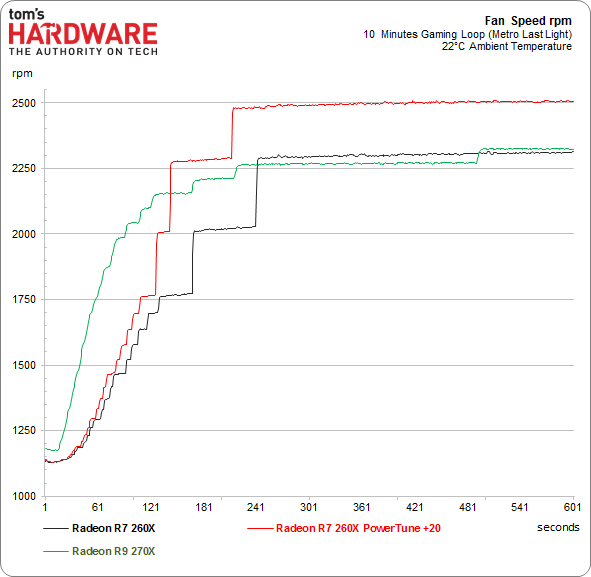AMD Radeon R9 280X, R9 270X, And R7 260X: Old GPUs, New Names
AMD is introducing a handful of new model names today, based on existing GPUs. Do the company's price adjustments make this introduction newsworthy, or will the excitement need to wait for its upcoming Radeon R9 290 and 290X, based on fresh silicon?
Fan Speed And Noise
Fan Speed
The R9 280X gets left out again, since we want to focus on the reference design, rather than partner boards that’ll all perform dissimilarly.
Since fan speed is one of the primary determinants of noise level, this chart is worth a close examination.
The temperature curves on the previous page suggested what we’d see here. The R9 270X ramps up fan speed in a more granular way, smoothing out the thermal plateau. The R7 260X tries to hold a lower fan speed for longer before stepping up suddenly. That’s where you saw temperatures peak before dropping back down to the 80-degree range.
Noise Level
AMD tends to put its emphasis on partner boards, which it has embargoed for another couple of days. We still wanted to generate some noise data with the reference cards, though.
They both idle under 32 dB(A), and are practically inaudible. Under the load of our custom gaming loop, the R7 260X demonstrates a modest 44.3 dB(A), while the R9 270X at 47.3 dB(A) is notably noisier. We wouldn’t recommend the cooling solution on either reference card. But again, partner boards typically have their own heat sinks and fans that need to be evaluated independently.
Get Tom's Hardware's best news and in-depth reviews, straight to your inbox.
Current page: Fan Speed And Noise
Prev Page Clock Rate And Temperature Next Page Old GPUs Ride Again, But That’s Not A Bad Thing-
CaptainTom Wow what's with the AMD hate? As it stands they are doing the same thing Nvidia did except without the outrageous prices. The GTX 770 wasn't a great deal when the 7970 was $50 cheaper. Have fun trying to run BF3 with 2GB of VRAM...Reply -
slomo4sho Nothing revolutionary but better prices I suppose.Reply
The MSI R9 280X Gaming at $299 appears to outperform the GTX 770 at 1600P and is within margin of error at 1080P according to Techpowerup. Not a bad value at $100 less and still overclocks well:
http://www.techpowerup.com/reviews/MSI/R9_280X_Gaming/26.html -
jimmysmitty So long story short, if you have a HD7970GHz then these do nothing for you.Reply
Best to hold out till the reviews on the R9-290X I guess. But considering the specs I hope for at least 20% performance increases over a 7970. -
Shankovich What happened to Chris? I didn't see this kind of hate with all of the 700 series rebrands. Also, to the Canadians here, grab the $270 7970 GHz edition cards while you still can.Reply -
BigMack70 I don't like this new strategy AMD and Nvidia are taking of rebranding an old series at improved price points and then releasing only one new chip at a stupidly expensive price point.Reply
Are the days of (nearly) annual simultaneous full line GPU launches from $100-500 with a dual GPU chip to follow at $750-1000 really over? -
cangelini Hate? The R9 280X won an *award*. I think Tahiti at $300 is pretty much brilliant.Reply
I wrote one of the least flattering GTX 780 stories out there. I only identified a couple of situations where a Titan made any sense at all. And although the 760 *did* change the balance at $250, that card still didn't get an award. I liked the 770 for the simple fact that it delivered better-than-680 performance for close to $100 less.
The rest of AMD's new line-up is a lot like what exists already. Again, the 7870 is a better value than 270X. So what are you getting worked up over? The fact that I'm pointing out these aren't new GPUs? They're not. ;) -
Shankovich Ok Chris, I agree with you, sorry for the over reaction. But I really don't like how nVidia made price increases for some of the rebrands. Looking forward to your 290 and 290X reviews :DReply -
ingtar33 i'll take a 7950 at $129 thank you very much (or two). There is a major retailer selling them for that this week. Best buy all year. two 7950s for the price of one r9-280x? yeah... i'll do that all day every day.Reply -
tomfreak Radeon 7790 has true Audio = but not enabled boooooo = as a 7790 owner I somewhat disappointed :( . Anyone have any idea if we can crossfire 1GB 7790 and 2GB 260x?Reply -
net_nakul By the time a R9 380X comes out, the GCN Tahiti XT achitecture may be 4 years old (assuming end of 2015). AMD better come up with an awesome new architecture by then, considering the R&D time they have.Reply
That goes to you too Mr. NVIDIA

